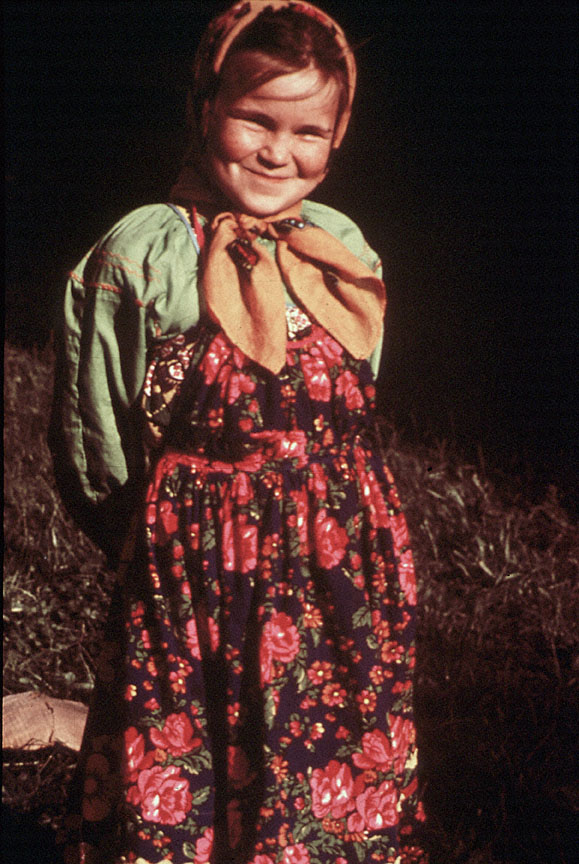- Catalog No. —
- S 1-353
- Date —
- 1989
- Era —
- 1981-Present (Recent Oregon History)
- Themes —
- Folklife, Race, Ethnicity, and Nationality, Religion
- Credits —
- Oregon Historical Society Folklife Program
- Regions —
- Willamette Basin
- Author —
- Joanne B. Mulcahy
Russian Old Believers
This photograph of an unidentified child in peasant-style clothing was taken by Folklife Coordinator Joanne Mulcahy in 1989 while she was documenting Oregon’s population of Russian Old Believers for the Oregon Folklife Program.
Old Believers are descendants of a group that rejected Russian Orthodox Church reforms enacted in 1654 to reconcile differences between Russian and Greek Orthodox texts. They broke away from the Orthodox Church because it objected to changes in Russian Orthodox traditions, such as ceremonies, icon painting, and book writing. Shortly after the schism, the Old Believers were persecuted; some were imprisoned and others were burned alive. Many Old Believers fled to remote villages in northern Russia or to Siberian wastelands and established tiny settlements. In these areas, they remained isolated from greater Russian society until Tsar Nicholas II proclaimed the Edict of Toleration in 1905, releasing the Old Believers from exile and persecution.
The Russian Revolution in 1917 encouraged many Old Believers to flee military conscription, classism, and starvation in the new Soviet Union. Many traveled to China and built colonies and farms in Manchuria’s Three Rivers Valley. At the beginning of the Cold War in the 1950s, communist pressure forced many Old Believers to emigrate from China and remote Soviet villages. They assembled in Hong Kong and at western Soviet ports where religious and social charities helped them find land in friendlier countries. Many settled in South America—particularly in Brazil. However, life was difficult in South America, thus many emigrated in the late 1960s. Reports of available farmland in the Willamette Valley motivated some 2,000 Old Believers to immigrate to Oregon where they established a small colony between Gervais and Mount Angel. In 2002, there were nearly 10,000 Old Believers in Oregon, the largest concentration in the United States.
Maintaining their medieval traditions continues to be challenging for the Old Believers. They adhere to traditional customs, including peasant-style clothing, as seen in this photograph taken in 1989. Women wear headscarves and long dresses, and adult males do not shave their beards. They observe 40 annual religious celebrations, making employment with local businesses nearly impossible. Thus, many Old Believers own businesses and farms. They are not allowed to eat from the same dishes as non-believers; so many Old Believers eat out only at fast-food restaurants, which use disposable containers. Nonetheless, there are signs of social compromise. Today, Old Believers drive automobiles and watch television.
Further Reading:
Colfer, A. Michael. Morality, Kindred and Ethnic Boundary: A Study of the
Oregon Old Believers. New York, N.Y., 1985.
Brother Ambros, A Short History of the Old Believer Communities in Oregon, 1979. Columbia River Basin Ethnic History Archive. Washington State University, Vancouver, Wash.
Written by Joshua Binus, © Oregon Historical Society 2005.
